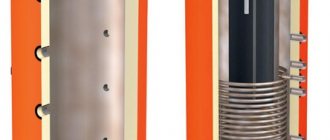This is an automatic circuit that controls the charging of the battery from solar panels and other power sources. It is based on 555 integrated circuits and charges the battery when its charge drops below a predetermined level, and then stops charging when the battery reaches its upper voltage limit.
Principle of operation
If there is no current from the solar battery, the controller is in sleep mode. It doesn't use a single watt from the battery. After sunlight hits the panel, electric current begins to flow to the controller. It should turn on. However, the indicator LED along with 2 weak transistors turns on only when the current voltage reaches 10 V.
Once this voltage is reached, current will flow through the Schottky diode to the battery. If the voltage rises to 14 V, amplifier U1 will start working, which will open the MOSFET transistor. As a result, the LED will go out and two low-power transistors will close. The battery will not charge. At this time, C2 will be discharged. On average this takes 3 seconds. After capacitor C2 discharges, the hysteresis of U1 will be overcome, the MOSFET will close, and the battery will begin to charge. Charging will continue until the voltage rises to the switching level.
Connection diagrams
There are 3 possible schemes for connecting solar panels to each other, these are: serial, parallel and series-parallel connection. Now about them in more detail.
Serial connection
In this circuit, the negative terminal of the first panel is connected to the positive terminal of the second, the negative terminal of the second to the third terminal, and so on. What this connection gives is that the voltage of all panels will be added. In other words, if you want to get, for example, 220V right away, this circuit will help you do it. but it is used extremely rarely.
Let's look at it with an example. We have 4 panels with a rated power of 12V each, Voc: 22.48V (this is the open circuit voltage), the output is 48V. Open circuit voltage = 22.48V*4=89.92V. in this case, the maximum current power, Imp, will remain unchanged.
In this scheme, it is not recommended to use panels with different Imp values, since the system efficiency will be low.
Parallel connection
This circuit allows you to increase the current without increasing the voltage of the panels. Let's look at an example. We have 4 panels with a rated power of 12V each, no-load voltage 22.48V, current at the maximum power point 5.42A. At the output of the circuit, the rated voltage and open-circuit voltage remain unchanged, but the maximum power will be 5.42A*4=21.68A.
Series-parallel connection
• Rated voltage of solar cell: 12V. • Open circuit voltage Voc: 22.48V. • Current at maximum power point Imp: 5.42A.
By connecting 2 solar panels in series and 2 in parallel at the output we get a voltage of 24V, an open circuit voltage of 44.96V, and the current will be equal to 5.42A*2=10.84A.
This makes it possible to get a balanced system and save on equipment such as a battery charge controller, since the emu will not need to withstand high voltage at peak operation. The circuit also makes it possible to use panels of different power, for example 2 of 12V, convert them to 24V. The most convenient network option for home.
Solar battery connection options
Solar panels are made up of several individual panels. To increase the system output parameters in the form of power, voltage and current, elements are connected to each other using the laws of physics.
Connecting several panels to each other can be done using one of three solar panel installation schemes:
- parallel;
- sequential;
- mixed.
A parallel circuit involves connecting terminals of the same name to each other, in which the elements have two common nodes for the convergence of conductors and their branching.
In a parallel circuit, “pluses” are connected to “pluses”, and “minuses” to “minuses”, as a result of which the output current increases, and the output voltage remains within 12 Volts
The maximum possible output current in a parallel circuit is directly proportional to the number of connected elements. The principles for calculating quantities are given in our recommended article.
A series circuit involves connecting opposite poles: the “plus” of the first panel to the “minus” of the second. The remaining unused “plus” of the second panel and the “minus” of the first battery are connected to the controller located further along the circuit.
This type of connection creates conditions for the flow of electric current, in which the only path remains for the transfer of energy from the source to the consumer.
With a serial connection scheme, the output voltage increases and reaches 24 Volts, which is enough to power portable equipment, LED lamps and some electrical receivers
A series-parallel or mixed circuit is most often used when it is necessary to connect several groups of batteries. By using this circuit, both the voltage and current can be increased at the output.
With a series-parallel connection circuit, the output voltage reaches a level whose characteristics are most suitable for solving the bulk of household problems
This option is also beneficial in the sense that if one of the structural elements of the system fails, the other connecting circuits continue to function. This significantly increases the reliability of the entire system.
The principle of assembling a combined circuit is based on the fact that devices within each group are connected in parallel. And all groups are connected in one circuit in series.
By combining different types of connections, it is not difficult to assemble a battery with the required parameters. The main thing is that the number of connected elements must be such that the operating voltage supplied to the batteries, taking into account its drop in the charging circuit, exceeds the voltage of the batteries themselves, and the load current of the battery provides the required amount of charging current.
Necessity
When the battery is at maximum charge, the controller will regulate the current supply to it, reducing it to the required amount to compensate for the self-discharge of the device. If the battery is completely discharged, the controller will turn off any incoming load to the device.
The need for this device can be reduced to the following points:
- Multi-stage battery charging;
- Adjusting the battery on/off when charging/discharging the device;
- Connecting the battery at maximum charge;
- Connecting charging from photocells in automatic mode.
A battery charge controller for solar devices is important because the performance of all its functions in proper mode greatly increases the service life of the built-in battery.
MPPT
The most advanced type of solar battery charge regulating device available on the market today is the MPPT. It allows you to increase the efficiency of electricity generation and its quantity from the same block of solar panels. The operating principle of any mppt module is based on tracking the so-called “maximum power point”.
Any mppt regulator constantly monitors the current and voltage parameters, based on which the microprocessor analytical unit calculates their most optimal ratio for generating full power. The processor, when choosing current and voltage ratings, also takes into account the stage of the charging process.
When using mppt controllers, it becomes possible to remove more voltage from the solar panels, which is then transformed into the optimal voltage for charging the battery (as a rule, it differs from the nameplate supply voltage). The overall efficiency of the solar system in comparison with PWM controllers increases by 15-35%. At the same time, MPRT technology allows you to work even when the panel illumination is reduced by 40%.
The advantages of MPPT modules can be displayed in the following diagram:
The ability to create high voltage at the output of the mppt controller allows you to use wires of a smaller cross-section and increase the distance between the unit itself and the solar panels.
Necessity
When the battery is at maximum charge, the controller will regulate the current supply to it, reducing it to the required amount to compensate for the self-discharge of the device. If the battery is completely discharged, the controller will turn off any incoming load to the device.
The need for this device can be reduced to the following points:
- Multi-stage battery charging;
- Adjusting the battery on/off when charging/discharging the device;
- Connecting the battery at maximum charge;
- Connecting charging from photocells in automatic mode.
A battery charge controller for solar devices is important because the performance of all its functions in proper mode greatly increases the service life of the built-in battery.
How can some components be replaced?
Any of these elements can be replaced. When installing other circuits, you need to think about changing the capacitance of capacitor C2 and selecting the bias of transistor Q3.
Instead of a MOSFET transistor, you can install any other one. The element must have low open channel resistance. It is better not to replace the Schottky diode . You can install a regular diode, but it must be placed correctly.
Resistors R8, R10 are equal to 92 kOhm. This value is non-standard. Because of this, such resistors are difficult to find. Their full replacement can be two resistors with 82 and 10 kOhm. They must be turned on sequentially .
Conclusions and useful video on the topic
The industry produces devices that are multifaceted in terms of circuit designs. Therefore, it is impossible to give unambiguous recommendations regarding the connection of all installations without exception.
However, the main principle for any type of device remains the same: without connecting the battery to the controller buses, connection to photovoltaic panels is unacceptable. Similar requirements apply for inclusion in a voltage inverter circuit. It should be considered as a separate module connected to the battery via direct contact.
If you have the necessary experience or knowledge, please share it with our readers. Leave your comments in the block below. Here you can also read about the topic of the article.
Price
A solar power supply system is assembled primarily to save money, so the price of individual parts is a very important point. The proposed options have stood the test of time and are the optimal combination of price/quality:
- Solar controller 20a – cost $20.75 – simple controls, bright LCD display, clear interface. Does an excellent job of charging the battery. PWM technology. It is possible to connect via USB to a computer for setup.
- MPPT Tracer 2210RN Solar Charge Controller Regulator, price $75 – 20A MTTP controller – high-quality and reliable, certified, recognizes day/night. High efficiency – 97%
Sources used:
sovet-ingenera.com, energo.house, electric-220.ru, alter220.ru, masterclub.online, electricadom.com
Selection options
There are only two selection criteria:
- The first and very important point is the incoming voltage. The maximum of this indicator should be higher by approximately 20% of the no-load voltage of the solar battery.
- The second criterion is the rated current. If the PWN type is selected, then its rated current should be higher than the short circuit current of the battery by approximately 10%. If MPPT is selected, then its main characteristic is power. This parameter must be greater than the voltage of the entire system multiplied by the rated current of the system. For calculations, the voltage is taken when the batteries are discharged.
Types used in practice
At the industrial level, two types of electronic devices have been launched and are being produced, the design of which is suitable for installation in a solar energy system:
- PWM series devices.
- MPPT series devices.
The first type of controller for a solar battery can be called “old man”. Such schemes were developed and put into operation at the dawn of the development of solar and wind energy.
The operating principle of the PWM controller circuit is based on pulse width modulation algorithms. The functionality of such devices is somewhat inferior to the more advanced devices of the MPPT series, but in general they also work quite effectively.
One of the popular solar station battery charge controller models in society, despite the fact that the device circuit is made using PWM technology, which is considered outdated
Designs using Maximum Power Point Tracking technology (tracking the maximum power limit) are distinguished by a modern approach to circuit solutions and provide greater functionality.
But if we compare both types of controller and, especially, with a bias towards the domestic sphere, MPPT devices do not look in the rosy light in which they are traditionally advertised.
MPPT type controller:
- has a higher cost;
- has a complex configuration algorithm;
- gives a gain in power only on panels of a large area.
This type of equipment is more suitable for global solar energy systems.
A controller designed for operation as part of a solar power installation. It is a representative of the class of MPPT devices - more advanced and efficient
For the needs of an ordinary user from a domestic environment, who, as a rule, has small-area panels, it is more profitable to buy and operate a PWM controller (PWM) with the same effect.











